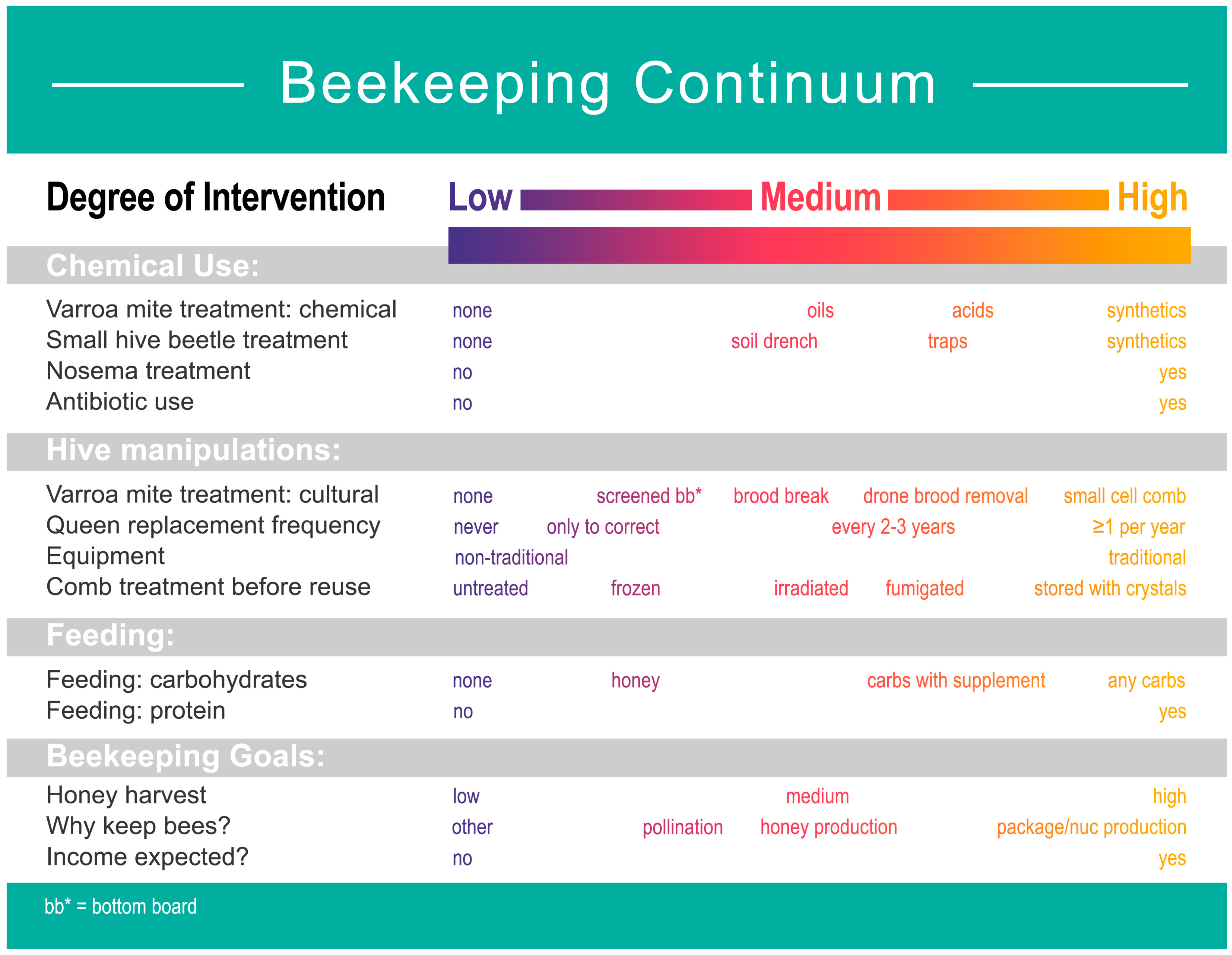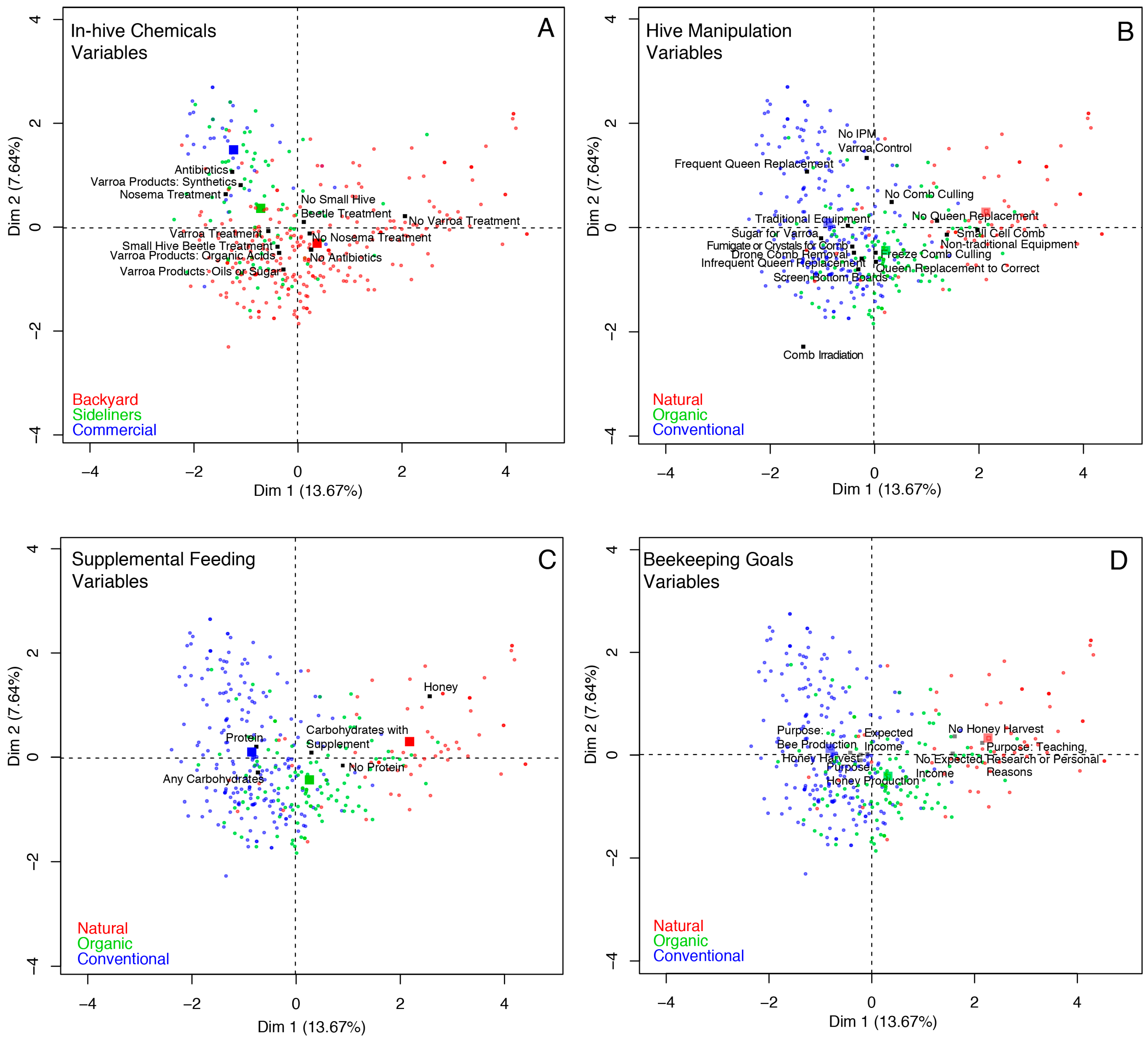Beekeeping Management Practices Are Associated with Operation Size and Beekeepers’ Philosophy towards in-Hive Chemicals
Abstract
:1. Introduction
2. Methods
3. Results
4. Discussion
5. Conclusions
Supplementary Materials
Author Contributions
Funding
Acknowledgments
Conflicts of Interest
References
- National Research Council. Status of Pollinators in North America; The National Academies Press: Washington, DC, USA, 2007; ISBN 978-0-309-10289-6. [Google Scholar]
- Goulson, D.; Nicholls, E.; Botías, C.; Rotheray, E.L. Bee declines driven by combined stress from parasites, pesticides, and lack of flowers. Science 2015, 347, 1255957. [Google Scholar] [CrossRef] [PubMed]
- Aizen, M.A.; Harder, L.D. The global stock of domesticated honey bees is growing slower than agricultural demand for pollination. Curr. Biol. 2009, 19, 915–918. [Google Scholar] [CrossRef] [PubMed]
- Steinhauer, N.; Rennich, K.; Caron, D.; Ellis, J.D.; Koenig, P.; Kulhanek, K.; Klepps, J.; Lee, K.; Milbrath, M.; Rangel, J.; et al. Colony Loss 2016–2017: Preliminary Results. Available online: https://beeinformed.org/results/colony-loss-2016-2017 (accessed on 21 February 2018).
- Project Apis m. A Seasonal Guide: Best Management Practices for Beekeepers Pollinating Almonds. Available online: http://www.projectapism.org/uploads/1/0/5/7/105706229/bmps-seasonal-guide.pdf (accessed on 8 January 2018).
- Morse, R.A.; Flottum, K. Honey Bee Pests, Predators, and Diseases, 3rd ed.; A.I. Root Company: Medina, OH, USA, 1997; 718p. [Google Scholar]
- vanEngelsdorp, D.; Meixner, M.D. A historical review of managed honey bee populations in Europe and the United States and the factors that may affect them. J. Invertebr. Pathol. 2010, 103, S80–S95. [Google Scholar] [CrossRef]
- Rosenkranz, P.; Aumeier, P.; Ziegelmann, B. Biology and control of Varroa destructor. J. Invertebr. Pathol. 2010, 103, S96–S119. [Google Scholar] [CrossRef] [PubMed]
- Lundie, A.E. The small hive beetle, Aethina tumida. Sci. Bull. Dep. Agric. For. Union S. Afr. 1940, 220, 5–19. [Google Scholar]
- Torto, B.; Boucias, D.G.; Arbogast, R.T.; Tumlinson, J.H.; Teal, P.E.A. Multitrophic interaction facilitates parasite-host relationship between an invasive beetle and the honey bee. Proc. Natl. Acad. Sci. USA 2007, 104, 8374–8378. [Google Scholar] [CrossRef]
- Zawislak, J. Managing Small Hive Beetles; University of Arkansas: Fayetteville, AR, USA, 1998; 6p. [Google Scholar]
- Neumann, P.; Pettis, J.S.; Schäfer, M.O. Quo vadis Aethina tumida? Biology and control of small hive beetles. Apidologie 2016, 47, 427–466. [Google Scholar] [CrossRef]
- Schäfer, M.O.; Ritter, W.; Pettis, J.; Neumann, P. Small hive beetles, Aethina tumida, are vectors of Paenibacillus larvae. Apidologie 2010, 41, 14–20. [Google Scholar] [CrossRef]
- Eyer, M.; Chen, Y.P.; Schäfer, M.O.; Pettis, J.; Neumann, P. Small hive beetle, Aethina tumida, as a potential biological vector of honeybee viruses. Apidologie 2009, 40, 419–428. [Google Scholar] [CrossRef]
- Eyer, M.; Chen, Y.P.; Schäfer, M.; Pettis, J.; Neumann, P. Honey bee sacbrood virus infects adult small hive beetles, Aethina tumida (Coleoptera: Nitidulidae). J. Apic. Res. 2009, 48, 296–297. [Google Scholar] [CrossRef]
- Higes, M.; Martín-Hernández, R.; Meana, A. Nosema ceranae in Europe: An emergent type C nosemosis. Apidologie 2010, 41, 375–392. [Google Scholar] [CrossRef]
- Martin, S.J.; Hardy, J.; Villalobos, E.; Martín-Hernández, R.; Nikaido, S.; Higes, M. Do the honeybee pathogens Nosema ceranae and deformed wing virus act synergistically? Environ. Microbiol. Rep. 2013, 5, 506–510. [Google Scholar] [CrossRef] [PubMed]
- Higes, M.; Martín-Hernández, R.; Botías, C.; Bailón, E.G.; González-Porto, A.V.; Barrios, L.; Del Nozal, M.J.; Bernal, J.L.; Jiménez, J.J.; Palencia, P.G.; et al. How natural infection by Nosema ceranae causes honeybee colony collapse. Environ. Microbiol. 2008, 10, 2659–2669. [Google Scholar] [CrossRef] [PubMed]
- DaRugna, U. Letter to Customers; Medivet Pharmaceuticals: High River, AB, Canada, 2018. [Google Scholar]
- Maistrello, L.; Lodesani, M.; Costa, C.; Leonardi, F.; Marani, G.; Caldon, M.; Mutinelli, F.; Granato, A. Screening of natural compounds for the control of nosema disease in honeybees (Apis mellifera). Apidologie 2008, 39, 436–445. [Google Scholar] [CrossRef]
- Gajger, T.; Vugrek, O.; Pinter, L.; Petrinec, Z. “Nozevit patties” treatment of honey bees (Apis mellifera) for the control of Nosema ceranae disease. Apic. Res. 2009, 149, 1053–1056. [Google Scholar]
- Gajger, I.T.; Petrinec, Z.; Pinter, L.; Kozaric, Z. Experimental treatment of Nosema disease with “Nozevit” phyto-pharmacological preparation. Am. Bee J. 2009, 149, 485–490. [Google Scholar]
- Hanson, F.R.; Eble, T.E. An antiphage agent isolated from Aspergillus sp. J. Bacteriol. 1949, 58, 527–529. [Google Scholar]
- Cantwell, G.E.; Shimanuki, H. Heat treatment as a means of eliminating nosema and increasing production. Am. Bee J. 1969, 109, 52–54. [Google Scholar]
- Cantwell, G.E.; Lehnert, T. Mortality of Nosema apis and the greater wax moth, Galleria mellonella L., caused by heat treatment. Am. Bee J. 1968, 108, 56–57. [Google Scholar]
- Hornitzky, M.A.Z. The use of gamma radiation in the control of honey bee infections. Australas. Beekeep. 1986, 88, 55–58. [Google Scholar]
- United States Food and Drug Administration. Helping Agriculture’s Helpful Honey Bees: Drugs to Control American Foulbrood. Available online: https://www.fda.gov/animalveterinary/resourcesforyou/animalhealthliteracy/ucm309134.htm (accessed on 27 August 2018).
- Sammataro, D.; Weiss, M. Comparison of productivity of colonies of honey bees, Apis mellifera, supplemented with sucrose or high fructose corn syrup. J. Insect Sci. 2013, 13, 1–13. [Google Scholar] [CrossRef] [PubMed]
- Mattila, H.R.; Otis, G.W. Influence of pollen diet in spring on development of honey bee (Hymenoptera: Apidae) colonies. J. Econ. Entomol. 2006, 99, 604–613. [Google Scholar] [CrossRef] [PubMed]
- DeGrandi-Hoffman, G.; Chen, Y.-P.; Huang, E.; Huang, M.H. The effect of diet on protein concentration, hypopharyngeal gland development and virus load in worker honey bees (Apis mellifera L.). J. Insect Physiol. 2010, 56, 1184–1191. [Google Scholar] [CrossRef] [PubMed]
- Michael, A.S. Beekeeping in the United States; Agriculture Handbook Number 335; U.S. Government Printing Office: Washington, DC, USA, 1980.
- Langstroth, L.L. A Practical Treatise on the Hive and the Honey-Bee; Cornell University Library: Ithaca, NY, USA, 1857; 568p. [Google Scholar]
- Crowder, L.; Harrell, H. Top-Bar Beekeeping: Organic Practices for Honeybee Health; Chelsea Green Publishing: White River Junction, VT, USA, 2012. [Google Scholar]
- Bernier, N.; Gillet, F. Structural relationships among vegetation, soil fauna and humus form in a subalpine forest ecosystem: A Hierarchical Multiple Factor Analysis (HMFA). Pedobiologia (Jena) 2012, 55, 321–334. [Google Scholar] [CrossRef]
- Mendez-Alonzo, R.; Paz, H.; Rossana, C.Z.; Rosell, J.A.; Olson, M.E. Coordinated evolution of leaf and stem economics in tropical dry forest trees. Ecology 2012, 93, 2397–2406. [Google Scholar] [CrossRef] [PubMed]
- Le, S.; Josse, J.; Husson, F. FactoMineR: An R Package for Multivariate Analysis. J. Stat. Softw. 2008, 25, 1–18. [Google Scholar] [CrossRef]
- RStudio Team. RStudio: Integrated Development for R; RStudio Inc.: Boston, MA, USA, 2015; Available online: http://www.rstudio.com/ (accessed on 1 June 2018).
- Sammataro, D.; DeGrandi-Hoffman, G.; Wardell, G.; Finley, J.; Ostiguy, N. Testing of a combination of control tactics to manage Varroa destructor (Acari: Varroidae) population levels in honey bee (Hymenoptera: Apidae). Int. J. Acarol. 2004, 30, 71–76. [Google Scholar] [CrossRef]
- Fakhimzadeh, K. Effectiveness of confectioner sugar dusting to knock down Varroa destructor from adult honey bees in laboratory trials. Apidologie 2001, 32, 139–148. [Google Scholar] [CrossRef]
- Macedo, P.A.; Wu, J.; Ellis, M.D. Using inert dusts to detect and assess varroa infestations in honey bee colonies. J. Apic. Res. 2002, 41, 3–7. [Google Scholar] [CrossRef] [Green Version]
- Steinhauer, N.; Rennich, K.; Caron, D.M.; Delaplane, K.S.; Rangel, J.; Rose, R.; Sagili, R.; Skinner, J.; Wilkes, J.T.; Wilson, M.E.; et al. Colony Loss 2015–2016: Preliminary Results. Available online: https://beeinformed.org/results/colony-loss-2015-2016-preliminary-results/ (accessed on 21 February 2018).
- Lee, K.V.; Steinhauer, N.; Rennich, K.; Wilson, M.E.; Tarpy, D.R.; Caron, D.M.; Rose, R.; Delaplane, K.S.; Baylis, K.; Lengerich, E.J.; et al. A national survey of managed honey bee 2013–2014 annual colony losses in the USA. Apidologie 2015, 46, 292–305. [Google Scholar] [CrossRef] [Green Version]




| Factor | Survey Question 1 | Response Category 2 |
|---|---|---|
| Chemical Use | Which, if any, of the following did you apply to any of your colonies between April 1, 2016 and April 1 2017? | |
| Varroa product used | Synthetics | |
| Organic acids | ||
| Essential Oils | ||
| None | ||
| Nosema product used | Y/N | |
| Antibiotics used | Y/N | |
| Small hive beetle treatment | Y/N | |
| Feeding | Which, if any, of the following did you apply to any of your colonies between April 1, 2016 and April 1 2017? | |
| Carbohydrates | Any carbs | |
| Carbs with supplement | ||
| Honey | ||
| None | ||
| Protein | Y/N | |
| Hive manipulations | Did you use any of the following IPM practices/equipment to try to control varroa mites? | |
| Small cell comb | ||
| Drone brood removal | ||
| Screened bottomboards | ||
| Brood break | ||
| None | ||
| Generally, how often do you replace queens in your colonies? | ||
| Frequently | ||
| Infrequently | ||
| To correct | ||
| Never | ||
| What hive type did you use to keep your colonies? | ||
| Traditional | ||
| Non-traditional | ||
| Last year, what did you do before you re-used brood comb that you have taken out of production or purchased? | ||
| Crystals or fumigate | ||
| Irradiated | ||
| Froze | ||
| Nothing | ||
| Beekeeping goals | Why did you keep bees? | |
| Bee production for sale | ||
| Honey production for sale | ||
| Other | ||
| Were you expecting to derive an income from your beekeeping activities? | Y/N |
| Dimension 1 | v.test | Dimension 2 | v.test | ||
|---|---|---|---|---|---|
| Beekeeping Philosophy | Natural | 82.887 | 19.313 | 0 | 0 |
| Organic | 6.072 | −5.664 | 64.516 | 18.464 | |
| Conventional | 11.040 | −9.408 | 35.484 | −16.867 | |
| Operation Size | Backyard | 0 | 0 | 29.679 | −19.313 |
| Sideline | 31.531 | −12.149 | 48.148 | 15.013 | |
| Commercial | 68.468 | 16.786 | 22.173 | 9.552 |
© 2019 by the authors. Licensee MDPI, Basel, Switzerland. This article is an open access article distributed under the terms and conditions of the Creative Commons Attribution (CC BY) license (http://creativecommons.org/licenses/by/4.0/).
Share and Cite
Underwood, R.M.; Traver, B.E.; López-Uribe, M.M. Beekeeping Management Practices Are Associated with Operation Size and Beekeepers’ Philosophy towards in-Hive Chemicals. Insects 2019, 10, 10. https://doi.org/10.3390/insects10010010
Underwood RM, Traver BE, López-Uribe MM. Beekeeping Management Practices Are Associated with Operation Size and Beekeepers’ Philosophy towards in-Hive Chemicals. Insects. 2019; 10(1):10. https://doi.org/10.3390/insects10010010
Chicago/Turabian StyleUnderwood, Robyn M., Brenna E. Traver, and Margarita M. López-Uribe. 2019. "Beekeeping Management Practices Are Associated with Operation Size and Beekeepers’ Philosophy towards in-Hive Chemicals" Insects 10, no. 1: 10. https://doi.org/10.3390/insects10010010
APA StyleUnderwood, R. M., Traver, B. E., & López-Uribe, M. M. (2019). Beekeeping Management Practices Are Associated with Operation Size and Beekeepers’ Philosophy towards in-Hive Chemicals. Insects, 10(1), 10. https://doi.org/10.3390/insects10010010






